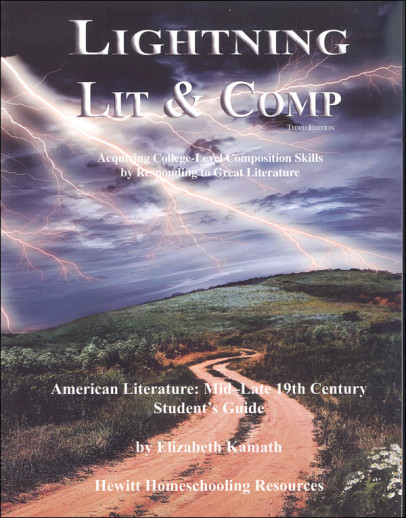We use cookies to make your experience better. To comply with the new e-Privacy directive, we need to ask for your consent to set the cookies. Learn more.
Lightning Literature & Composition American Literature Mid - Late 19th Century Student Guide
Students read in the following order:
- Harriet Beecher Stowe (novel:Uncle Tom's Cabin)
- Walt Whitman (selected poems from Leaves of Grass, text in this Guide)
- Bret Harte (short story, "The Outcasts of Poker Flat," text in this Guide)
- Mark Twain (novel:Huckleberry Finn)
- Paul Laurence Dunbar (selected poems, text in this Guide)
- Stephen Crane (novel:The Red Badge of Courage)
- Emily Dickinson (selected poems, text in this Guide)
- Jack London (novel:The Call of the Wild)
Lessons cover theme, humor, description, point of view, figurative language, register, and sound in poetry. The Student's Guide includes information about the authors, comprehension questions, writing exercises, discussion questions and project suggestions, reading lists appropriate to the period or subject, semester and full-year schedules, and a bibliography. The answers to comprehension questions are in the Teacher's Guide.
Recommendations: This book isespecially recommendedfor freshmen, students new to Lightning Literature in any high school grade, students taking American History, or students interested in American literature. These should not be viewed as restrictions as this course can profitably be used by high school students of any grade regardless of which previous Lightning Literature courses they have completed.
Language arts programs listed in this section cover most areas of language arts (reading/literature, writing, grammar, spelling and handwriting) in one curriculum, although some skill areas may be covered with less intensity than a focused, stand-alone course.
"Reading should be fun, and writing should be satisfying." The author of this series believes this, and she has produced courses that try to keep that goal ever present. She WANTS students to enjoy themselves! Accordingly, reading assignments are comfortable - two novels, two non-fiction books, two short stories and several poems for the 7th grade course, for instance. Lessons are well-constructed and the excellent and thorough coverage includes vocabulary, comprehension, literary elements, composition, grammar, and mechanics.
The three components of this program are designed to be complementary and to be used together. The Student Workbook is the student's textual companion as they study the literature selections. This consumable book is the place for the student to "do" their work. It provides worktext space for all the essential exercises as well as some optional fun/reinforcement exercises.
The Teacher Guide is the "glue" that holds the whole program together providing a philosophical and methodical overview of the program and a weekly planning schedule (lesson plans) as well as chapter-by-chapter answers and teaching helps.
The last component is the excellent Literature Selections that are the heart of the program. Classics, familiar, non-familiar, poetry, and, occasionally, surprising choices all find their way onto the book lists for each grade level. While you may be able to locate some or all of the books at a library, we also offer Literature Packages for each guide that include the necessary books. You and your student are encouraged to read, enjoy, and profit from the year's literature studies. ~ Janice
Written directly to the student, well-organized, user-friendly (no teacher prep), and both traditional and diverse in the reading selections, these courses offer quality literary analysis coupled with step-by-step writing instruction. Assignments are thought-provoking and challenging.
Lessons follow a pattern: Introduction, (information about the reading) Selection, While You Read, Comprehension Questions, Literary Lessons, and Writing Exercises. Suggested activities enhance the studies: Vocabulary Notebook, Reading Journal, Biographies, Family Reading or Writing Nights, Oral Summaries, Writing Group, and (perhaps) Movies.
The Student Book includes instructional text, shorter works (i.e. poetry, excerpts), author background, discussion questions (comprehension, thought, literary), and writing exercises. The Teacher Guide provides answers, schedules, teaching/grading tips, rubrics, project suggestions/checklists, and grade-tracking records.
The twelve semester-long courses are listed in order of difficulty. Most students should start with one of the American Lit courses. There are required literature resources to use with each guide. While you may be able to locate some or all of the books at a library, we also offer Literature Packages for each course that include the Student Book, the Teacher Guide, and the necessary literature books.
Lessons cover theme, humor, description, point of view, figurative language, register, and sound in poetry. The Student Guide includes information about the authors, comprehension questions, writing exercises, discussion questions and project suggestions, reading lists appropriate to the period or subject, semester and full-year schedules, and a bibliography. The Teacher's Guide is needed if you want the answers to the comprehension questions. It also provides a teaching schedule, teaching and grading aids, and a copy of the writing exercises and discussion questions for the teacher's convenience. The Course Package includes the Student Book, the Teacher Book, and any necessary literature selections not included in the text of the Student Book.
This book is especially useful for freshmen students, students new to Lightning Literature in any high school grade, students taking American History, or students interested in American literature. However, the course can be used by any high school students of any grade without any previous experience in Lightning Literature courses.
| Product Format: | Paperback |
|---|---|
| Brand: | Hewitt Research Foundation |
| Author: | Elizabeth Kamath |
| Grades: | 9-12 |
| ISBN: | 9781578962402 |
| Length in Inches: | 10.75 |
| Width in Inches: | 8.375 |
| Height in Inches: | 0.4375 |
| Weight in Pounds: | 1.1 |

